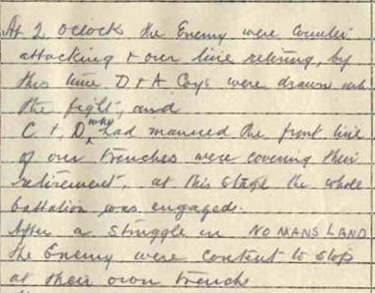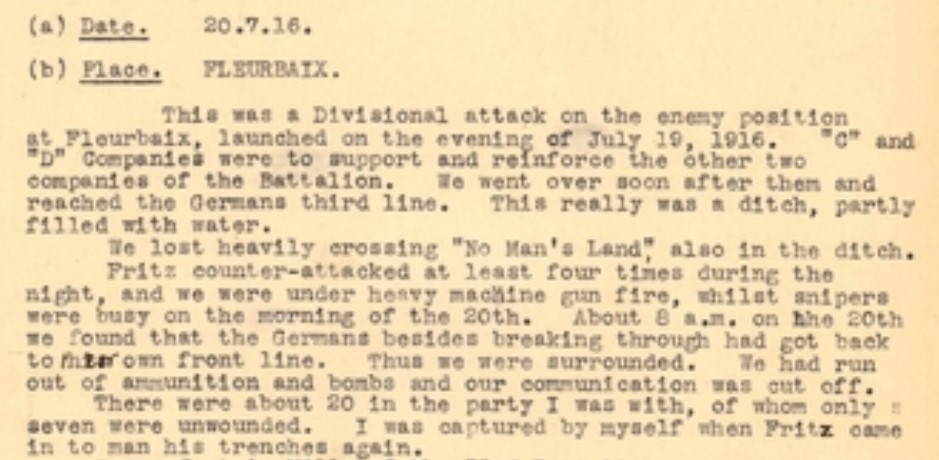William Gordon KENNEDY
Eyes blue, Hair fair, Complexion fair
Gordon William Kennedy – A Pioneer of the 29th
Early Life
William Gordon Kennedy, known as Gordon, was born in Williamstown, Victoria in July 1892. He was one of eleven children of John “Jack” and Annie (nee Topen) Kennedy.
Gordon’s father worked on the railways and their children were born in different parts of Victoria. Gordon worked as a labourer prior to enlistment in 1915. Gordon’s younger brother Leslie Frederick Kennedy was killed in action at the Battle of Fromelles.
Off to War
Gordon enlisted in July 1915 and was assigned to the 29th Battalion, D Company (No. 1154). His brother Leslie tried to enlist, twice, but was rejected because of his height, finally measured at 5’ 2 ¼” when he was able to join. Gordon was 5’ 5 ¾“. When Leslie was accepted he requested to be with his brother and was initially assigned to the 29th Battalion, A Company before moving to D Company.
The boys’ younger brother Wallace, 5’ 2”, enlisted in May 1918 when he was old enough. He remained in Australia. A cousin of the boys, Thomas Kennedy (6291), served in 14th Battalion.
With the Western Front ramping up, Gordon sailed for Egypt from Melbourne on 10 Nov 1915. Gordon finally was joined his brother Leslie on 25 May 1916 at the Ferry Post camp on the Nile River. After further month of training, the brothers left Egypt for the Western Front aboard the Tunisian, arriving in Marseilles on 23 June.
They were put on trains to Hazebrouck and Steenbeque and were finally encamped in Morbecque by the 26th, about 30 km from Fleurbaix. The Aussies were well received by the French. In a letter home, James Lang (858), 29th Battalion from Glengarry, Victoria, wrote:
“The French people lined the streets to see us, and gave us a great welcome. Lots of poor women and young girls started crying. No doubt the poor things were thinking of their own dear ones who had gone to the front.”
Gas masks were now included in their training for the possible use of “lachrymatory shells” – tear gas. Training was tough. One day included a march of 16 miles carrying a 75 lb kit, which only the youngest and fittest could complete. On 9 July the 29th were moved to Erquingham, just outside of Fleurbaix and on the 10th they got their first experience in the trenches, with the “men all in good spirits”.
Source: AWM4 23/46/12 29th Infantry Battalion July 1916 page 3
They were back at their billets in Fleurbaix four days later. A gas alarm was sounded on the 15th, but there was no effect on the troops in Fleurbaix.
Fromelles

The 29th’s role in the upcoming battle was to be a ‘fourth’ battalion on the left flank of the attack. With the 30th they were to provide support for the attacking 31st and 32nd Battalions by digging trenches, carrying supplies/ammunition and to be called in as reserves if needed for the fighting. The original attack was planned for the 17th, but bad weather caused it to be postponed.
On 19 July the 29th were in the rear trenches, ready for the attack. The 32nd’s charge over the parapet began at 5.53 PM and the 31st’s at 5.58 PM. There were machine guns emplacements to their left and directly ahead at Delrangre Farm and there was heavy artillery fire in No-Man’s-Land. The initial assaults were successful and by 6.30 PM the Aussies were in control of the German’s 1st line system, which was described as:
“practically a ditch with from 1 to 2 feet of mud and slush at the bottom.”
By 8.00 PM, Gordon and Leslie’s D Company and A Company began to carry bombs and supplies to the front trenches. The Australians’ left flank had also come under heavy bombardment with high explosives and shrapnel. Return bombardment support was provided and the 32nd was told - “the trenches were to be held at all costs”.
Source: AWM4 23/49/12, 32nd Battalion War Diaries, July 1916, page 12
At 10.00 PM, additional support was being requested and Gordon and Leslie’s D Company and C Company joined in. Unfortunately, they found that a number of the grenades they were carrying had no fuses. The Germans counter attacked and at 2.00 AM and by this time the brothers were fully engaged in the fighting.
B and C Companies continued to carry supplies and provide cover for soldiers who were retiring from the battle. However, “After a struggle in No-Man’s Land, the Germans were content to stop at their own trench.”
Source: AWM4 23/46/12, 29th Battalion War Diaries, July 1916, page 7

At 2 O’clock the enemy were counter attacking….
Fighting continued through the night. At 4.00 AM the Germans began an attack from the Australian’s left flank, bombing and advancing into the communications trench. Given the Australian advances that had been made earlier, portions of the rearward trench had been left almost empty, which then enabled the Germans to be in a position to surround the advanced soldiers.

With the Australian attack having been halted, they became exposed in a salient jutting into the German lines and were quickly enfiladed by German machine guns. “In the end, they basically had to fight their way back to their own lines, 'run for it', or be killed, wounded or captured.”
Source: 29th Battalion VWMA https://vwma.org.au/explore/units/111
In the morning the battle was over. The 29th were left to hold the front line and, even though a cease fire was not in effect, they were busily bringing back a large number of wounded. The nature of this battle was summed up by Private Jim Cleworth (784) from the 29th:
"The novelty of being a soldier wore off in about five seconds, it was like a bloody butcher's shop".
For a battalion supposed to be in a support role, the initial figures of the impact of the battle on the 29th was 17 soldiers died, 161 were wounded and 68 were missing. To get some perspective of the battle, when Charles Bean, Australia’s official war historian, attended the battlefield two and half years later, he observed a large amount of bones, torn uniforms and Australian kit still on the battlefield.
Ultimately, 63 soldiers of the 29th Battalion were killed in action or died of wounds from the battle and 37 of them were unable to be identified.
Leslie’s Fate
Gordon survived the battle, but Leslie was among the missing.

Ralph Wakeling survived the War.
There are other reports that say Leslie was shot through the head and that the trench he may have been in was destroyed by shell fire, but all were clear that Leslie had been killed in the battle. As above, Gordon did all he could to find out about his brother, but then he had the unenviable task of sending the sad news home.

While the family knew Leslie had been killed in action, no further details were provided by the Army for more than a year. A 23 August Court of Inquiry finally declared Leslie as having been killed in action. None of his personal items were found that could be returned to his family. Lesley was clearly missed.
After the Battle
While the loss of his brother was devastating, Gordon had to ‘soldier on’ and remained with the 29th Battalion, spending Christmas 1916 in the trenches. He sprained his ankle in September 1917 and was moved to the 14th and 15th training battalions. He was promoted to Lance Corporal in 1917 and to Corporal in 1918.
Gordon was trained at the Australian School of Musketry at Tidworth throughout 1918. He returned to the 29th Battalion at the battlefront east of Amiens in September 1918.


In 1918 he wrote home to his parents:
Mrs. Kennedy, of No. 1, Pleasant-street, Newtown, has received letters from her son, Cpl. Gordon Kennedy, the latest, dated France, 22.9.18. His battalion, the 29th, was then resting in country that Fritz had been driven from shortly before. In regard to himself, he was in the pink of condition, and in splendid spirits; he felt like jumping over everything in his road, and wanted to sing, all the time. He speaks enthusiastically of his mate, Sergt. Les. Grogan, of West Geelong, who had been very severely wounded, but was now convalescent. He says Les was very highly thought of in his company; four of his mates were severely wounded in the attempt to bring him from No Man's Land. the one that brought him in got the Military Medal. He had a very close call; his spirit pulled him through. The doctor who had charge of him said he was one of the bravest men he had met. Gordon says, "And I know it; he was a true mate and a dinkum soldier. I miss him." Gordon wishes to be remembered to all his friends.
Gordon luckily “came through (the War) unscathed” – his mother Annie’s comments.
Source: AWM Roll of Honour Circular, Kennedy Leslie Frederick
In 1919, he was welcomed home.
Gordon married twice and had three children. He returned to the Geelong District and worked as a textiler before retiring. He died in 1973 and is buried in Geelong Eastern Cemetery. You can read his brother Leslie Kennedy’s story here.
He is remembered at the Victorian Garden of Remembrance, Springvale, Victoria.
Lest we forget.
Links to Official Records
The Fromelles Association would love to hear from you

Contacts
(Contact: carla@fromelles.info or geoffrey@fromelles.info).
(Contact: army.uwc@defence.gov.au or phone 1800 019 090).
Donations
If you are able, please contribute to the upkeep of this resource.
(Contact: bill@fromelles.info ).




